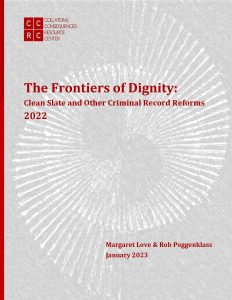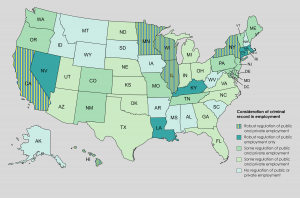DC enacts progressive new record-clearing law
Until last month, the District of Columbia had one of the most complex and restrictive record relief laws in the country. D.C.’s sealing law even applied the same burdensome petition-based procedures, extended waiting periods, and onerous burdens of proof to non-conviction records that applied to convictions. In testimony before the D.C. Council in 2021, CCRC’s Margaret Love noted: “Compared to states across the country, DC’s record relief laws are very prohibitive and unusually complex.” CCRC’s Reintegration Report Card published in March 2022 commented that “the restoration laws in the District of Columbia are noteworthy for a remarkable study in contrasts: D.C. has extraordinarily progressive laws in civil areas like voting, employment, housing, and occupational licensing, and among the most regressive laws in the Nation in every category of criminal record relief, likely reflecting the heavy hand of the federal authorities that are responsible for most prosecutions under the D.C. Code.”
Last month, everything changed. The Second Chance Amendment Act of 2022 (D.C. Law 24-284, codified at D.C. Code § 16-801 et seq.), which became final after the required period of congressional review on March 16, 2023, gave the District one of the broadest record-clearing laws in the country, including both petition-based relief for all but the most serious violent felony convictions, and automatic relief for misdemeanors and non-conviction records. D.C. now becomes the 11th U.S. jurisdiction to enact a “clean slate” law that applies to both conviction and non-conviction records.
The new D.C. record-clearing law is the product of more than two years of hard work by the D.C. Council and a broad coalition of advocacy groups in the District. When coupled with the District’s progressive civil restoration laws referenced above, this new law propels DC from middle-of-the-pack to the top tier of jurisdictions in the Nation where fair treatment of justice-affected individuals is concerned. It will certainly advance DC’s candidacy for Reintegration Champion of 2023.
Though D.C. Law 24-284 is enacted, it is unfunded, which means it cannot be used. Currently, the FY24 Budget Support Act of 2023 set the effective date for the Second Chance Act as 1/1/26 for most of the law and 10/1/29 for the automatic sealing provisions.
The new law’s specific provisions are described in greater detail below, and in the DC profile from CCRC’s Restoration of Rights Project.
The new D.C. law provides for petition-based sealing for all non-conviction records at disposition, for all misdemeanors after a five-year waiting period, and for all but a specified group of the most serious felony convictions after an eight-year waiting period. The waiting period begins following completion of all aspects of the sentence, except that it does not require payment of fines and other court debt. The law also facilitates procedures: e.g., not all eligible records need be sealed at the same time, as under the old law, and there are no “disqualifying offenses” that could extend the waiting period even for non-conviction records.
It also eases standards, particularly for sealing non-conviction records: it deleted a provision allowing the court to consider “the weight of the evidence against the person” and any priors sealings of arrest records. It specifically directs the court in all cases to consider “The community’s interest in furthering the movant’s rehabilitation and enhancing the movant’s reintegration into society through education, employment, and housing.” As noted, D.C.’s existing sealing law extended to same burdensome procedures and standards to non-conviction records that applied to sealing of convictions.
The new law makes sealing automatic beginning in 2027 for non-conviction records, and for most misdemeanor convictions after a 10-year waiting period. It also provides for automatic expungement of marijuana convictions effective January 1, 2025, and for expungement by petition on grounds of actual innocence. Provisions in existing law authorizing expungement for victims of human trafficking and sealing for juvenile defendants were not changed.
D.C. now joins the 19 states that have enacted automatic record-clearing relief for arrest records and other non-convictions. More than half of these state laws have been enacted in the three years since publication of CCRC’s Model Law on Non-Conviction Records, which advocated for automatic expungement of all non-conviction records, including records with no final disposition, except for pending matters. Like CCRC’s model law, which was cited as authority by several parties during the hearings before the D.C. Council, the new D.C. law recommends restrictions on accessing, inquiring about, and commercially disseminating non-conviction records.
Sealed records are placed in a non-public file but remain available to law enforcement, courts, prosecutors, licensing agencies, public employers, and schools and child care facilities, to be used “for any lawful purpose.” Sealed records may also be used in civil litigation relating to the arrest or conviction, and may be made available to others “upon order of the Court for good cause shown.” An individual whose record has been sealed may deny the arrest or conviction “for any purpose”, without penalty of perjury or other provision of the law for giving a false statement. This appears to be a change from the 2006 law, which required testimony about prior arrests and convictions “in response to an inquiry from one of the entities expressly authorized to access the records.” In other words, while certain entities may gain access to sealed records, the subject of the record may lawfully deny its existence without penalty.
The 2022 law imposes certain requirements on “criminal history providers” that provide criminal history background screening reports, requirements that mirror those provided by the federal Fair Credit Reporting Act. It requires providers to provide the subject of a background report with a copy of the report and identify the source of the report, and to use at least two identifiers (e.g., birthdate and name); prohibits reporting records that have been sealed, expunged or set aside; and pohibits reporting information that has not been updated within 30 days of the report. Complaints of a violation of these provisions may be filed with the DC Office of Human Rights (but not in court), and fines are specified for violations.
There are still ways that D.C.’s sealing law could be improved. For example, there appears to be no good reason why sealed non-conviction records should remain available to employers and licensing agencies, and in most states they are not. Automatic relief should be extended to all convictions now subject to sealing by petition, and the waiting periods for both petition-based and automatic relief seem excessive by standards in recently enacted record-clearing laws. See CCRC’s 2022 report on waiting periods, Waiting for Relief: A National Survey of Waiting Periods for Record Clearing (February 2022). But those caveats aside, the new law represents the most substantial progress in record clearing of any U.S. jurisdiction since 2018, when North Dakota and New Mexico enacted a broad sealing scheme for the first time. Congratulations to the D.C. Council!





